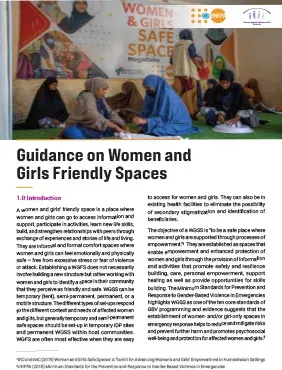A women and girls’ friendly space is a place where women and girls can go to access information and support, participate in activities, learn new life skills, build, and strengthen relationships with peers through exchange of experiences and stories of life and living. They are informal and formal comfort spaces where women and girls can feel emotionally and physically safe – free from excessive stress or fear of violence or attack. Establishing a WGFS does not necessarily involve building a new structure but rather working with women and girls to identify a space in their community that they perceive as friendly and safe. WGSS can be temporary (tent), semi-permanent, permanent, or a mobile structure. The different types of set-ups respond to the different context and needs of affected women and girls, but generally temporary and semi-permanent safe spaces should be set-up in temporary IDP sites and permanent WGSS within host communities. WGFS are often most effective when they are easy to access for women and girls. They can also be in existing health facilities to eliminate the possibility of secondary stigmatization and identification of beneficiaries.
The objective of a WGSS is “to be a safe place where women and girls are supported through processes of empowerment.”[1] They are established as spaces that enable empowerment and enhanced protection of women and girls through the provision of information and activities that promote safety and resilience building, care, personal empowerment, support healing as well as provide opportunities for skills building. The Minimum Standards for Prevention and Response to Gender-Based Violence in Emergencies highlights WGSS as one of the ten core standards of GBV programming and evidence suggests that the establishment of women- and/or girl-only spaces in emergency response helps to reduce and mitigate risks and prevent further harm and promotes psychosocial well-being and protection for affected women and girls.[2]


